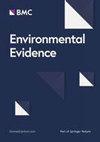What are the impacts of activities undertaken in UNESCO biosphere reserves on socio-economic wellbeing in Southeast Asia? A systematic review
IF 5.2
4区 环境科学与生态学
Q2 ENVIRONMENTAL SCIENCES
引用次数: 0
Abstract
UNESCO biosphere reserves (BRs) have historically aimed to play a crucial role in contributing to sustainable development by bringing about win–win outcomes for both biodiversity and socio-economic development. However, recent studies show the need for a more thorough understanding of how conservation activities impact on and are affected by socio-economic development. We built this systematic review on a systematic map by Eales et al. [14] adding studies from further academic database and grey literature searches specifically designed for this systematic review. Because studies were not sufficiently homogeneous in their outcomes to warrant a valid meta-analysis, we used narrative synthesis to explore the studies’ findings. We assessed 10,053 titles and abstracts from database searches and Google Scholar. 343 articles were screened at full text and 16 studies were included in our review. Of the 16 studies, 3 were assessed as having overall high validity, 8 having moderate validity and 3 having low validity of evidence. 2 studies did not provide sufficient information for validity categorisation (unclear validity). Effects on economic living standards, reported in 11 studies, were in both desired and undesired directions, though most high validity studies reported no significant difference, and most others did not test for significance. Most studies reported that BR interventions were associated with positive impacts on material living standards. In general, studies reported good relations between local people and local enforcement/government following interventions in BRs. BR interventions may both reduce or cause social conflict, though the higher validity studies showed results in the desired direction. In one study, there was a positive impact on population family planning outcomes, when a reproductive health intervention was implemented with conservation efforts. There was no clear impact in either direction regarding education. Across two studies the overall message is positive for the subjective wellbeing of local people. With 727 BRs worldwide, the BR model has been accepted and developed as an approach to facilitate the implementation of the UN's SDGs. However, our work shows that interventions implemented in UNESCO BRs can bring about impacts in quite diverse ways: positive, negative, unchanged, and may often present both positive and negative impacts in the same situation. This reconfirms that the expected win–win outcomes of UNESCO BR model in terms of biodiversity and socio-economic development should be more carefully considered. We suggest some main points for consideration, particularly when developing management mechanisms for UNESCO biosphere reserves and/or managing activities in biosphere reserves. We also highlight the need for further research to explore the socio-economic impacts of the UNESCO biosphere reserves in Southeast Asia, especially on the domains of freedom of choice and action, security and safety, and culture and spirituality. Moreover, it is vital to have research projects that measure long-term impacts of biosphere reserves, which have been lacking in previous work. Finally, the potential impact of external factors should be considered in programme and monitoring design.在教科文组织生物圈保护区开展的活动对东南亚的社会经济福祉有何影响?系统审查
教科文组织生物圈保护区历来致力于通过为生物多样性和社会经济发展带来双赢的结果,在促进可持续发展方面发挥关键作用。然而,最近的研究表明,需要更彻底地了解保护活动如何影响和受社会经济发展的影响。我们在Eales等人[14]的系统地图上构建了本系统综述。[14]添加了来自进一步的学术数据库和专门为本系统综述设计的灰色文献检索的研究。由于研究结果的同质性不足以保证有效的荟萃分析,我们使用叙事综合来探索研究结果。我们从数据库检索和Google Scholar中评估了10053篇标题和摘要,筛选了343篇文章的全文,其中16篇研究纳入了我们的综述。在16项研究中,3项被评估为总体高效度,8项为中等效度,3项为低效度。2项研究没有提供足够的信息进行效度分类(不明确的效度)。在11项研究中,对经济生活水平的影响既有期望的方向,也有不希望的方向,尽管大多数高效度研究报告没有显著差异,而大多数其他研究没有检验显著性。大多数研究报告BR干预与物质生活水平的积极影响有关。一般来说,研究报告了在br干预后当地人民与当地执法/政府之间的良好关系。BR干预既可能减少社会冲突,也可能导致社会冲突,尽管较高效度的研究显示结果朝预期的方向发展。在一项研究中,在努力保护的情况下实施生殖健康干预,对人口计划生育结果产生了积极影响。在教育方面,这两个方向都没有明显的影响。在两项研究中,总的来说,当地人的主观幸福感是积极的。全球有727个BR, BR模式已被接受并发展为促进联合国可持续发展目标实施的一种方法。然而,我们的工作表明,在联合国教科文组织br中实施的干预措施可以以多种方式产生影响:积极的、消极的、不变的,并且在同一情况下往往可能同时产生积极和消极的影响。这再次证实,应更仔细地考虑教科文组织BR模式在生物多样性和社会经济发展方面的预期双赢结果。我们提出了一些值得考虑的要点,特别是在制定联合国教科文组织生物圈保护区管理机制和/或管理生物圈保护区活动时。我们还强调需要进一步研究,以探索教科文组织生物圈保护区在东南亚的社会经济影响,特别是在选择和行动自由、安全和文化和精神等领域的影响。此外,有研究项目来衡量生物圈保护区的长期影响是至关重要的,这在以前的工作中是缺乏的。最后,在方案和监测设计中应考虑到外部因素的潜在影响。
本文章由计算机程序翻译,如有差异,请以英文原文为准。
求助全文
约1分钟内获得全文
求助全文
来源期刊

Environmental Evidence
Environmental Science-Management, Monitoring, Policy and Law
CiteScore
6.10
自引率
18.20%
发文量
36
审稿时长
17 weeks
期刊介绍:
Environmental Evidence is the journal of the Collaboration for Environmental Evidence (CEE). The Journal facilitates rapid publication of evidence syntheses, in the form of Systematic Reviews and Maps conducted to CEE Guidelines and Standards. We focus on the effectiveness of environmental management interventions and the impact of human activities on the environment. Our scope covers all forms of environmental management and human impacts and therefore spans the natural and social sciences. Subjects include water security, agriculture, food security, forestry, fisheries, natural resource management, biodiversity conservation, climate change, ecosystem services, pollution, invasive species, environment and human wellbeing, sustainable energy use, soil management, environmental legislation, environmental education.
 求助内容:
求助内容: 应助结果提醒方式:
应助结果提醒方式:


